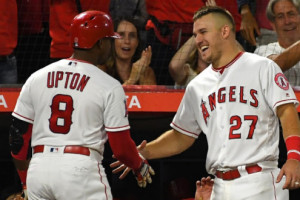MLB DFS: wOBA Trouble

People are always looking for a quick and easy way to gauge a player’s skill level, and wOBA has become the standard. I don’t want to sound like I’m picking on wOBA here, because it is probably the best standalone metric we have to use, but baseball was never meant to be measured by any one number. If you’re unfamiliar with wOBA, it stands for Weighted On-Base Average. It was created by Tom Tango in his popular work, ‘The Book’. If you want to read all about the nitty gritty details of how it is calculated, FanGraphs has a good explanation of it. Basically, it combines all the aspects of hitting and weighs them towards their overall run production. Everything that is used in the basic slash line stats; batting average, on-base percentage, slugging percentage, is figured into wOBA to more accurately show how each player contributes to run scoring.
The league average wOBA is very close to the league average On-Base Percentage. So far this year, the average wOBA is .311 and the average OBP is .315. Similar to OBP, a .400 wOBA is elite territory, anything over the .350 range is very good, while .300 or under is poor.
The problem with wOBA is that our old friends BABIP and HR/FB% are not factored in. As I’ve written about in the past, and can be found in plenty of other studies, BABIP (batting average on ball in play) and HR/FB% (home run/fly ball percentage) are very subject to luck and random periods of fluky outcomes.
I want to state very clearly that wOBA is an excellent tool that can and should be used. My point here is not that wOBA isn’t a great tool, but that there is no one metric that can measure everything we need to know to succeed at DFS. You need to look at the whole picture when evaluating players and not allow yourself to be influenced by one number that may not tell an accurate story.
With that as a backdrop, I want to take a look at some players who have a wOBA split that does not fit in with their career numbers, and see what we should expect going forward. I’m going to look at the basic skills of some players last three seasons with strikeout rate (K%), walk rate (BB%), BABIP, HR/FB% and ground ball/line drive/fly ball percentage (G/L/F). I’m going to look not just at the overall wOBA of these hitters, but their splits against a particular handedness of pitcher. My goal here is not to present an exhaustive list of players, but help you see the thought process of how to determine if a low wOBA is predictive of future performance, or if you should expect a rebound.
Carlos Santana vs LHP – Career: .362 wOBA – 2015: .289 wOBA
2013 vs LHP – .375 wOBA – 14.2% K% – 10.8% BB% – .329 BABIP – 12.8% HR/FB – 46/24/30 G/L/F
2014 vs LHP – .381 wOBA – 15.3% K% – 16.7% BB% – .292 BABIP – 14% HR/FB – 43/17/39 G/L/F
2015 vs LHP – .289 wOBA.– 15.6% K% – 14.4% BB – .295 BABIP – 0% HR/FB – 50/21/28 G/L/F
A zero percent HR/FB rate is the obvious culprit here for the severe drop in wOBA against left-handed pitchers. He does have a noticeable increase in his ground ball percentage which would lead to an overall drop in extra base hits, but his fly ball rate is only 5% below his career 33% rate, so it’s not as if he’s dropped off the table. Players do not get nearly as many at bats over the course of a season against left-handed pitchers, so it’s easier for an outlier like that 0% to last longer into the year without it meaning there is any true change in skill level.
Jonathan Lucroy vs LHP – Career: .364 wOBA – 2015: .219 wOBA
2013 vs LHP – .370 wOBA – 10.4% K% – 7.4% BB% – .321 BABIP – 11.6% HR/FB – 37/24/39 G/L/F
2014 vs LHP – .367 wOBA – 12.3% K% – 9.7% BB% – .345 BABIP – 2.3% HR/FB – 37/26/37 G/L/F
2015 vs LHP – .219 wOBA – 17.6% K% – 8.8% BB% – .184 BABIP – 6.3% HR/FB – 44/24/32 G/L/F

This is another easy one. A quick glance at wOBA and you would think you should avoid Lucroy against lefties, but it’s really just a matter of an incredibly low BABIP. I can find a reason why his wOBA from both 2013-2014 might have been artificially high (HR/FB in 2013 and BABIP in 2014), but despite an increase in strikeout rate, Lucroy still makes solid contact for a catcher, and over time will get back to the .300 BABIP mark, bringing his wOBA up with it.
Evan Gattis vs LHP – Career: .323 wOBA – 2015: .266 wOBA
2013 vs LHP – .338 wOBA – 17.3% K% – 6.7% BB% – .270 BABIP – 16.1% HR/FB – 44/17/39 G/L/F
2014 vs LHP – .419 wOBA – 26.0% K% – 2.7% BB% – .404 BABIP – 19.2% HR/FB – 25/25/50 G/L/F
2015 vs LHP – .266 wOBA – 15.9% K% – 3.3% BB% – .231 BABIP – 9.8% HR/FB – 48/18/34 G/L/F
These numbers are all over the place, and very interesting to break down. The first thing to notice is that 2014 was an outlier on the opposite side of the spectrum, as his high BABIP led to a fluky high wOBA. Beyond the wOBA, however, his strikeout and fly ball numbers jump off the page; in 2014 it appears he was very intentionally swinging for the fences with a high K rate and huge fly ball percentage. This year, he has brought his strikeout rate back down to a strong level and is hitting fewer fly balls. Regardless of approach, Gattis is clearly suffering bad luck on BABIP and HR/FB this season and his wOBA is artificially low.
Victor Martinez vs RHP – Career: .356 wOBA – 2015: .267 wOBA
2013 vs RHP – .354 wOBA – 8.3% K% – 9.0% BB% – .323 BABIP – 7.4% HR/FB – 42/23/35 G/L/F
2014 vs RHP – .390 wOBA – 5.8% K% – 11.6% BB% – .306 BABIP – 13.8% HR/FB – 43/20/37 G/L/F
2015 vs RHP – .267 wOBA – 12.8% K% – 5.8% BB% – .215 BABIP – 9.0% HR/FB – 40/19/41 G/L/F
Like Jonathan Lucroy, Martinez does have an increase in his strikeout rate this season, so that will decrease his overall numbers, but a .215 BABIP from a player with 10 consecutive seasons of a BABIP over .300 is clearly an outlier.
Justin Upton vs LHP – Career: .380 wOBA – 2015: .228 wOBA
2013 vs LHP – .422 wOBA – 22.0% K% – 22.0% BB% – .293 BABIP – 25.6% HR/FB – 34/24/42 G/L/F
2014 vs LHP – .423 wOBA – 30.2% K% – 13.7% BB% – .348 BABIP – 30.6% HR/FB – 35/18/47 G/L/F
2015 vs LHP – .228 wOBA – 31.5% K% – 7.6% BB% – .245 BABIP – 8.7% HR/FB – 36/22/42 G/L/F

The .228 wOBA of Justin Upton against lefties is possibly the single oddest stat that I have seen. What is going on here? A .200 point drop from the last two seasons is severe, and while the BABIP and HR/FB are both low, there is some reason for concern here. His 30.2% strikeout rate last season got overlooked because he was hitting for enough power to overshadow it, but now that his walk rate and HR/FB rate have dropped, we see how much damage a high strikeout rate can do. It was reasonable to expect some drop in HR/FB with the move to San Diego, but certainly he should be closer to 20% in that category. He has good speed, so his BABIP should have no problem coming up towards .300. But even when all that evens out, you need to be aware that his strikeout rate against lefties puts him in the Chris Carter class of hitter; that is not a compliment.
These are just a few examples of players whose wOBA is not a completely accurate measure of their skill set. Again, wOBA is a great tool, and I use it every day in my analysis, but it is not the be and end all of metrics. Don’t try to shortcut your way to DFS success; there are lots of statistics available, and there’s no reason to try and settle for just one.